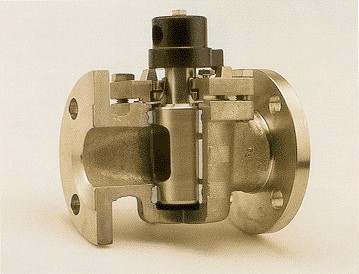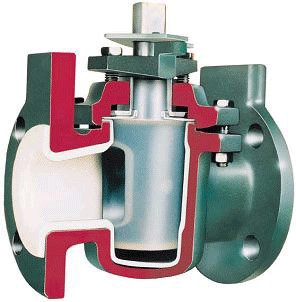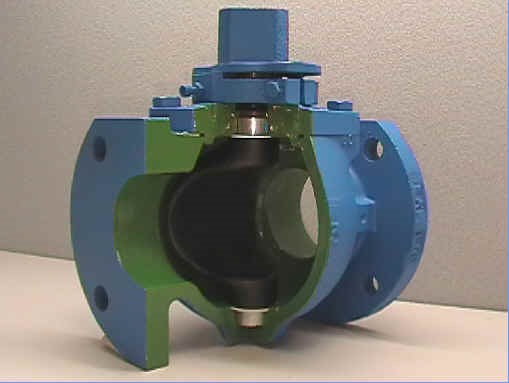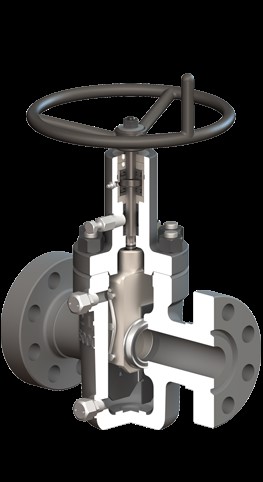1. Non-Lubricated Plug Valve
2. Lubricated Plug Valve
3. Eccentric Plug Valve
4. Expanding Plug Valve
A plug valve is a quarter-turn on-off valve. The plug can be cylindrical or tapered and has a variety of port types. Plug valves are available in either a lubricated or non-lubricated design. Plug valve ends can be flanged, hub type or butt weld.
1. Non-Lubricated Plug Valve
Non-lubricated plug valves contain a polymeric body liner or a sleeve, which is installed in the body cavity. The tapered and polished plug acts like a wedge and presses the sleeve against the body. The nonmetallic sleeve reduces the friction between the plug and the body. Like for soft-seated ball valves, non-lubricated plug valves are limited by temperature and chemical compatibility of the non-metallic materials used. Non-lubricated plug valves are used instead of lubricated plug valves, where maintenance needs to be kept to a minimum. They can be used in special services (e.g. sulphur and hydrogen fluoride), since they do not have a body cavity in open communication with the flow when switching, where fouling liquids could be trapped or solidify, potentially jamming the valve. These valves are not torque seated.

Fig.1: Non-Lubricated Plug Valve
2. Lubricated Plug Valve
Lubricated plug valves will be of inverted pressure balance type only and shall be used if the product allows the use of lubricant. Lubricants shall contain base oil and a viscosity improver like amorphous or fumed silica. They perform well in processes where the fluid carries mildly abrasive particles. The plug and body tapered bores are matched together to form a relatively wide seat area. The plug bore is normally reduced but full port is available for slurry applications with high solid content where these valves are particularly more suitable than other types. Full port valves are considerably more expensive than reduced port and normally not used in hydrocarbon applications.
The sealant or lubricant establishes a seal between the plug and the body, protects the seating surfaces against corrosion, and acts as a lubricant, thus reducing the force required to open or close the valve. The sealant is injected periodically, perhaps after twenty operations, or after long periods without operation. An automatic lubrication device can be fitted. Failure to lubricate may render the valve un-operable. In most designs, the plug can be lifted from the seat through manual adjustment of a jacking screw. Solids may become trapped between plug and seat after such intervention, impairing reliable shut-off. Damaged seating can sometimes be restored in service using the sealant facility.
Lubricated plug valves are typically used in dirty upstream applications, where contamination of the process fluid is not a cause of concern. The valves are however heavier and more expensive than ball valves. They are also extensively used on gas pipeline systems as bypass valves to mainline ball valves, blow-down valves on valve stations and kicker valves. They can be delivered in exotic materials such as duplex SS and Inconel overlaid.
These valves are not torque seated.
For double block and bleed non-piggable upstream applications, where space and weight is a consideration, double isolation plug valves may be considered instead of two valves in series.

Fig.2: Lubricated Plug Valve
Other plug valve designs, which are non-lubricated and can therefore be used downstream, are the eccentric and expanding plug designs.
3. Eccentric Plug Valve
The eccentric plug valve is essentially a plug valve with the plug cut in half. The advantage of this design is a higher seating force with minimal friction encountered from the open to closed position. Shut-off capabilities are improved without a significant increase in operating torque. These valves are torque seated.

Fig.3: Eccentric Plug Valve
4. Expanding Plug Valve
The expanding plug valve is a special design in which the plug is made of multiple components allowing it to mechanically expand through a wedging action onto the cylindrical body. These valves, although expensive, give a true double block and bleed function in a single valve, and are ideal for preventing product contamination (e.g. in oil movement operations). However these valves shall not be used as a means of “double isolation” for maintenance purposes, as it is still likely that a single failure will affect both blocking functions. These valves are torque seated.

Fig.4: Expanding Plug Valve
Additional design features
Plug valves are double seated valves which incorporate a cavity between the seats, or above and below the plug; the cavity relief requirements shall be applied.
Non-metal-seated plug valves and non-lubricated plug valves with non-metallic sleeves handling flammable fluids shall be provided with an antistatic device which achieves electrical continuity between the plug, stem and the valve body.